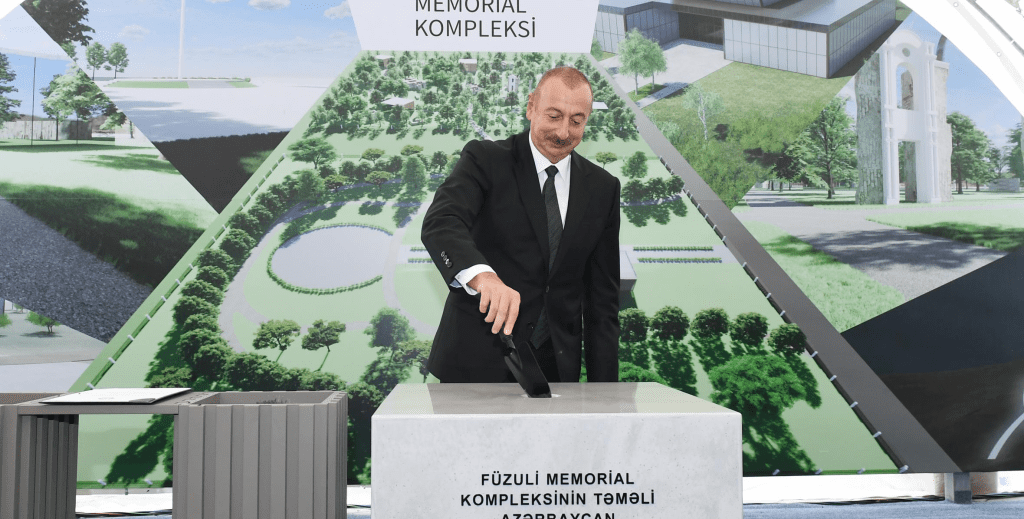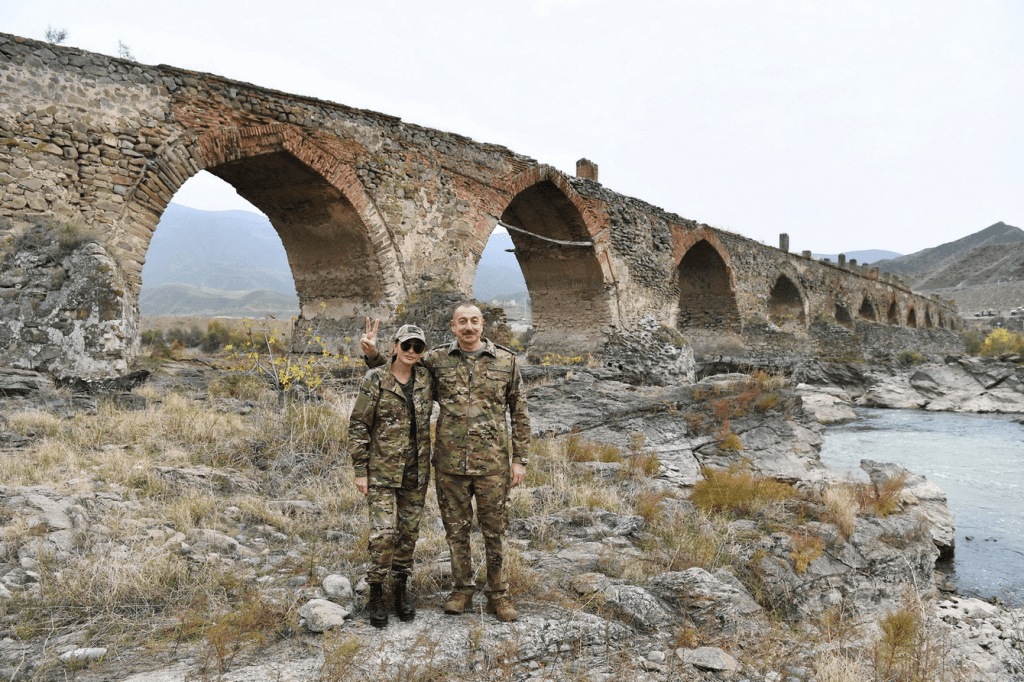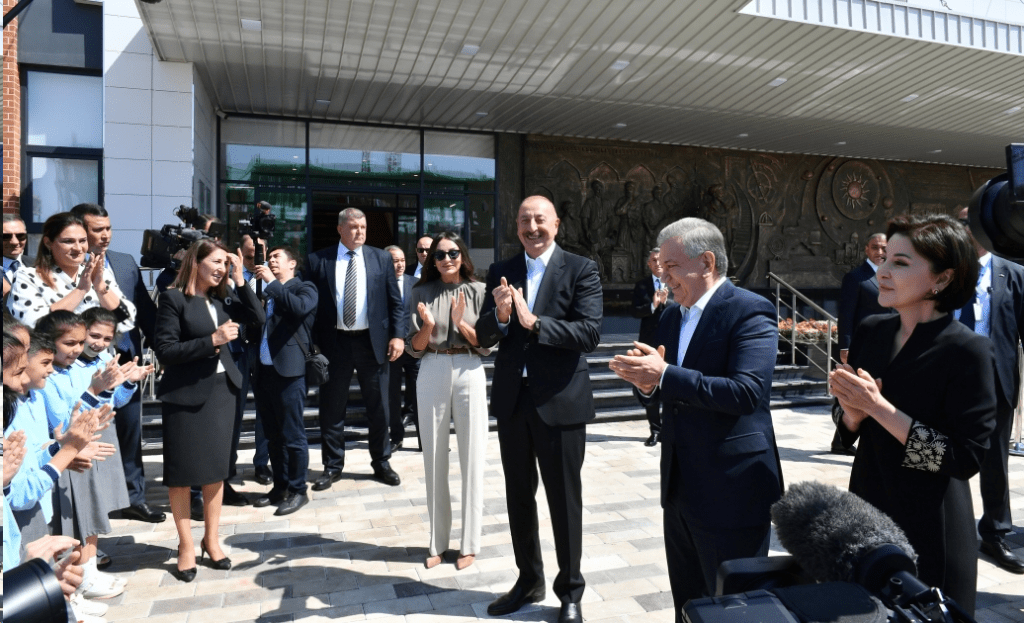
The Fuzuli region stretches along the picturesque gentle plains and lowlands of the south-eastern foothills of the Karabakh ridge to the Araz River – the border with Iran, on the other hand it borders with the Jebrail, Khojavend, Agjabedi and Beylagan regions of the Republic of Azerbaijan. Fuzuli city itself stands on the Guruchay River, a small tributary of the Araz river. In the spring, people use this river to irrigate the fields located along its banks.

Araz river

Fuzuli is a small town in Karabakh, and received its name in 1959, in honor of the great medieval Azerbaijani poet and scientist Muhammad Fizuli. Until the 19th century, there was a small village of Garabulag (“gara” in Azerbaijani language – “black”, “bulag” – “spring”) in this place. Since Garabulag was located on the border with Gajar Iran, with which the Russian Empire waged endless wars, in 1872 the village was renamed Karyagino – in honor of the hero of the Russian-Persian War, Colonel Pavel Karyagin. In the second quarter of the 19th century, the persecution of adherents of Christian sects began in the Russian Empire. Most of them did not claim anything, but the Church did not want to put up with their existence, and Emperor Alexander I issued a decree on the forced relocation of sectarians to the outskirts of the empire. This is how many Molokans ended up in the South Caucasus, including in Garabulag: here they founded 24 farms. The Molokans lived amicably with their neighbors. When the village was almost burned out due to a strong fire in 1872, the new settlers managed to survive only thanks to the help of residents of the surrounding villages. Fizuli region is known for its ancient Guruchay culture. This place is a real paradise for archaeologists. At different times, excavations were carried out in Garakepektepe, on the Garabulag mounds, in Guneshtepe, on the banks of the Guruchay River. In 1968, in the Azykh Cave, employees of the archeology and ethnography sector of the Institute of History of ANAS discovered the lower part of the skull of the most ancient person in the territory of the former USSR and the fourth in the world, who was called an Azykhanthropus. This became a big event in the scientific world: it was proven that the ancestors of modern people already lived in the Lower Paleolithic on the territory of the Fuzuli region. And these are very picturesque places. Especially in spring, grass grows in the meadows, and tulips, which bloom like a carpet, cover the mountain slopes from the town of Fuzuli to the village of Goradis. In Soviet times, the Fuzuli region was prosperous. There were butter and cheese production, wine production, asphalt plants, reinforced concrete factories, and weaving factories. Sericulture has long been the most profitable industry, with 22 silk factories operating in the district. But one of the main economic items was winemaking. Its volume reached 55% of industrial sales in the region. The famous port wine “Agdam” was produced from Fuzuli grapes.

President of Uzbekistan Shavkat Miromonovich gifted this school to the city of Fuzuli.
Currently, the area is actively developing and looks like one large construction site. Historical buildings, palaces and mosques are being restored. Industrial facilities and agriculture have been restored, socio-economic infrastructure has been created, power lines, heating mains and gas pipelines have been launched. In 2021, Fuzuli International Airport opened, construction of a 65-kilometer highway to Agdam already started, roads between Hadrut, Fuzuli and Jabrail are almost completed. And in the city center there is a huge park, a hospital is planned to be built, and a school and modern residential areas are almost completed.

Azerbaijani poet Fuzuli
Fuzuli is the literary pseudonym of the 16th century poet, thinker and scientist Muhammad ibn Suleiman. From Farsi this word can be translated as “bold”, “brave”.
The poet was born in 1494 in the city of Karbala (a city in Iraq). Most researchers agree that the poet was from the Turkic Bayat tribe, which roamed the area from the Trans-Caspian Sea to Syria and eventually settled in Iraq. The poet’s father served as mufti in the city of El-Hilla near Karbala and was a wealthy man, judging by the fact that young Muhammad received an excellent education for that time: he even studied in Baghdad, then the world center of natural sciences. The future thinker studied medicine, astronomy, logic, mathematics and philosophy, and was familiar with the works of Aristotle and Plato. He knew very well the works of eastern classic poets – Nizami Ganjavi, Khagani, Nasimi and Habibi, and he himself wrote in three languages: Azerbaijani, Arabic and Farsi. The poem “Leyli and Majnun” was first written in Azerbaijani by the poet Fuzuli. But the first to write the poem “Leyli and Majnun” was the Azerbaijani classical poet Nizami. Nizami wrote in Persian. Fuzuli’s influence can be traced not only in the literature of the entire Middle East, but also in the Azerbaijani and Turkish musical traditions. Starting from the 17th century, the poet’s poems set to music were performed by folk musicians-ashugs, accompanying themselves on the saz. And khanende singers used his poems in mugams – the amazing musical and poetic art of Azerbaijan.
The Ghiyas Ad-Din Mosque in the village of Gargabazar was built in the 17th century during the reign of the Azerbaijani Safavid dynasty. Even the exact year of construction is known – 1682. A stone structure with an arched roof stands on a hill in the center of the village of the same name. On the wooden entrance door there is an inscription: “This mosque was built by Haji Ghiyas ad-Din, the merciful servant of the Almighty.”
Nearby there is an ancient caravanserai, a one-story multi-tiered asymmetrical building made of rough stone. It was built in a traditional inn style with a series of rooms with arched vaults resembling corridors. Sometimes this historical monument is called the caravanserai of Shah Abbas I (1587-1629).
The Mausoleum of Sheikh Yagub, a rare example of medieval architecture, appeared in the village of Baba in 1272. On the eight-ranged structure made of white limestone, a Kufic (this is the name of one of the oldest types of Arabic writing) phrase has been preserved: “I ordered the construction of this mashhad by the perfect ascetic sheikh Yagub ibn Ismail Gur Khar in 672.” People call this place Shykhbaba. The mausoleum belongs to the Nakhchivan architectural school – it is also called the Memar Ajemi school. Of several minarets, only one has survived to this day, and only partially; the rest were destroyed during the Russian-Persian wars of the 19th century. But both internal rooms of the mausoleum have been preserved – the underground tomb and the chamber located above it. The above-ground part has a small portico and is covered with a round dome made of thin limestone slabs. In the summer of 2011, archaeologists arrived in the village of Baba and discovered six stone tombstones next to the tomb. And the main find is the ruins of the khanegah. This is the name given to buildings characteristic of that time, a refuge for Sufis. Khanegahs were built near sacred feasts; They prayed in them, held debates, and studied. As a rule, the complex consisted of a mausoleum, a mosque, utility rooms, as well as cells for students and a caravan barn. It was the caravanserai that was originally the khanegah in Baba.
Mirali’s mausoleum was erected at the beginning of the 14th century. A stone tower rises near the old road from Beylagan to Barda. A narrow 15-meter cylindrical body grows from a low pedestal. The entire surface of the monument is covered with images of people, animals, birds and geometric figures carved on stone. The underground part is designed in the shape of a cross. Its four branches are covered with pointed vaults, and the central square part is covered with a dome, at its highest point 3.27 meters from the floor level. In the middle of the central chamber there is a low vertical slab without inscriptions. Probably, it marks the burial place of the person in whose honor the mausoleum was built.
Garakepektepe.
Places near Fuzuli have long attracted the attention of archaeologists. In 1898, the Garabulag burial mound was discovered on the right bank of the Kendelanchay. And in the 1960s, scientists discovered an entire multi-layered ancient settlement. During excavations in Garakepektepe, many objects of material culture of the Middle Bronze Age were found, which in this region began in the second half of the 3rd millennium BC. These objects are typical for the tribes of the Mil-Karabakh steppe of that period.
Leletepe.
In 2019, an expedition of the National Academy of Sciences of Azerbaijan excavated a mound with a height of 6.4 meters and an area of 0.9 hectares in the Fuzuli region and discovered an ancient ziggurat and three buildings. In one of them there were two jugs, bone and stone tools, dishes, and under the ruins a child’s skeleton. Not far away, scientists came across a whole burial – eight graves with 14 human skeletons. Malachite, stone and bone jewelry were found next to the remains. The find caused a great stir in the scientific world: Leletepe turned out to be the first Neolithic burial discovered in the South Caucasus.
Reservoir.
There are four reservoirs on the territory of the Fuzuli region, the most important of which is Ashagy Kendelanchay, created on the Guruchay River flowing through the region. Commissioned in 1980, it is capable of providing water resources to 6,300 hectares of land. The volume of the water reservoir is 9.5 million cubic meters, the length of the dam is 925 meters, the height is 25 meters, and the surface area is 1.53 square kilometers. The throughput capacity of the waterworks is 20 cubic meters per second. Ashags of Kendelanchay feed two more reservoirs in the Fuzuli region: Kendelanchay-1, built in 1951, and Kendelanchay-2 (1962). In 2021, environmentalists released,1000 kutum fry and 500 grass carp fry into Kendelanchay 1, – fish that have long been found in the waters of the Fuzuli rivers.

Airport.
Despite its small size, Fizuli boasts its own international airport. It was built in just six months and equipped with the latest technology. The length of the runway is three kilometers, the area of the summer field apron is 60 thousand square meters, the capacity is 200 passengers per hour.


